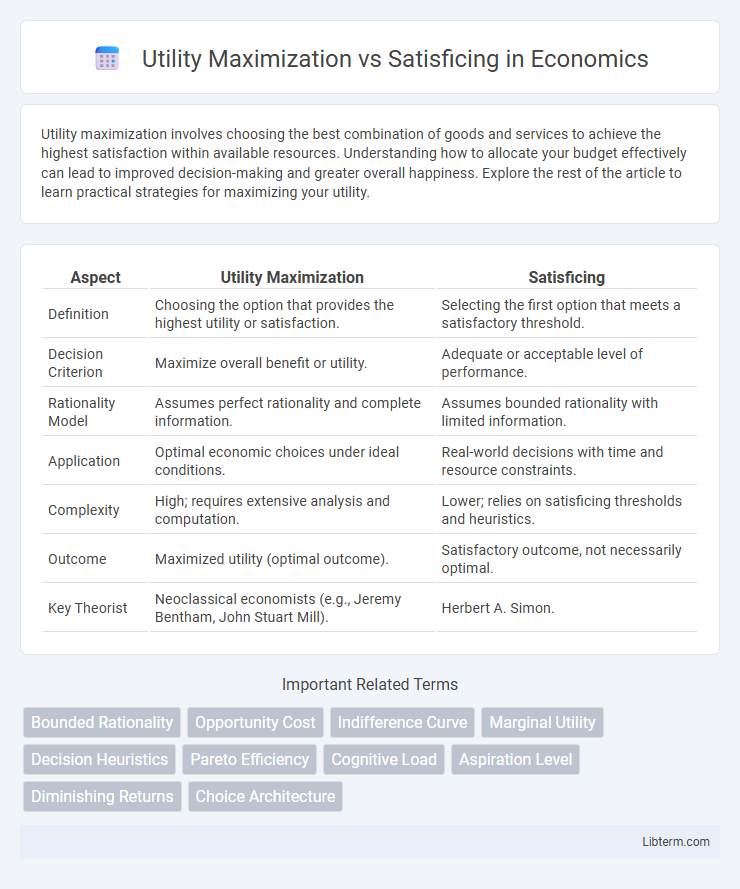Utility maximization involves choosing the best combination of goods and services to achieve the highest satisfaction within available resources. Understanding how to allocate your budget effectively can lead to improved decision-making and greater overall happiness. Explore the rest of the article to learn practical strategies for maximizing your utility.
Table of Comparison
| Aspect | Utility Maximization | Satisficing |
|---|---|---|
| Definition | Choosing the option that provides the highest utility or satisfaction. | Selecting the first option that meets a satisfactory threshold. |
| Decision Criterion | Maximize overall benefit or utility. | Adequate or acceptable level of performance. |
| Rationality Model | Assumes perfect rationality and complete information. | Assumes bounded rationality with limited information. |
| Application | Optimal economic choices under ideal conditions. | Real-world decisions with time and resource constraints. |
| Complexity | High; requires extensive analysis and computation. | Lower; relies on satisficing thresholds and heuristics. |
| Outcome | Maximized utility (optimal outcome). | Satisfactory outcome, not necessarily optimal. |
| Key Theorist | Neoclassical economists (e.g., Jeremy Bentham, John Stuart Mill). | Herbert A. Simon. |
Introduction to Utility Maximization and Satisficing
Utility maximization involves selecting the option that provides the highest level of satisfaction or benefit, often quantified through economic or decision-making models. Satisficing, in contrast, emphasizes choosing an acceptable or satisfactory option that meets predefined criteria rather than seeking the absolute best. These concepts guide decision-making strategies by weighing the trade-offs between optimality and practicality in resource allocation and cognitive effort.
Defining Utility Maximization
Utility maximization refers to the decision-making process where individuals or firms aim to achieve the highest possible satisfaction or benefit from their choices by evaluating all available options and selecting the one with the greatest expected utility. This concept is fundamental in economics and assumes rational behavior, where preferences are complete and transitive. Utility maximization contrasts with satisficing, which involves selecting an option that meets acceptable criteria rather than optimizing.
Understanding the Satisficing Approach
The satisficing approach prioritizes achieving a satisfactory or "good enough" outcome rather than the optimal solution sought in utility maximization. This decision-making strategy reduces cognitive load and resource expenditure by setting acceptable thresholds instead of exhaustive evaluation of all alternatives. Behavioral economics and bounded rationality theories highlight satisficing as a practical model in complex environments with limited information and time.
Historical Background and Theoretical Foundations
Utility maximization traces its roots to classical economics and the 18th-century work of Jeremy Bentham, who introduced the principle of maximizing overall happiness or utility in decision-making. Herbert A. Simon challenged this model in the 1950s by proposing satisficing as a more realistic alternative, emphasizing bounded rationality and the limitations of human cognitive capabilities. The theoretical foundation of utility maximization is grounded in neoclassical economics and expected utility theory, while satisficing aligns with behavioral economics and decision theory, highlighting trade-offs between optimality and realistic decision processes.
Key Differences Between Utility Maximization and Satisficing
Utility maximization involves choosing the option that provides the highest possible benefit or value, relying on comprehensive analysis and optimization of outcomes. Satisficing, by contrast, entails selecting the first option meeting acceptable criteria, prioritizing efficiency and practicality over optimization. Key differences include the decision scope--utility maximization seeks optimal solutions while satisficing accepts good-enough outcomes--and cognitive resource usage, where utility maximization requires extensive information processing, whereas satisficing reduces decision-making complexity.
Cognitive Processes in Decision-Making
Utility maximization involves selecting the option that provides the highest perceived value based on comprehensive evaluation of available choices, relying heavily on analytical and rational cognitive processes. Satisficing, by contrast, emphasizes achieving an acceptable threshold of satisfaction rather than the optimal outcome, engaging heuristic-driven and bounded rationality mechanisms to reduce cognitive load. These cognitive strategies reflect different approaches to decision-making under conditions of complexity and limited information processing capacity.
Real-World Applications: Which Approach Prevails?
Utility maximization often guides economic models and consumer behavior analysis, enabling optimal allocation of resources and maximizing satisfaction under constraints. Satisficing, however, dominates real-world decision-making where complexity, time limitations, and imperfect information prompt individuals and firms to seek sufficiently good solutions rather than the absolute optimum. Empirical studies in behavioral economics and organizational management reveal satisficing as the prevailing approach in practical settings, reflecting bounded rationality and pragmatic problem-solving.
Advantages and Limitations of Each Strategy
Utility maximization aims to achieve the highest possible benefit by analyzing all available options, ensuring optimal decision-making in complex scenarios but often requiring extensive time and cognitive resources, which can be impractical in urgent situations. Satisficing, by setting a threshold of acceptability, enables quicker decisions with lower cognitive load, making it effective in environments with limited information or time; however, it may result in suboptimal outcomes by settling for "good enough" rather than the best option. Both strategies rely on different cognitive processes: utility maximization leverages exhaustive evaluation and rational analysis, while satisficing depends on heuristics and satisficing criteria, highlighting a trade-off between decision quality and efficiency.
Psychological and Behavioral Insights
Utility maximization assumes individuals make decisions by systematically evaluating all options to achieve the highest satisfaction, whereas satisficing acknowledges cognitive limitations and embraces "good enough" choices to reduce decision fatigue. Psychological studies reveal that satisficing reduces stress and improves decision speed, highlighting bounded rationality in human behavior. Behavioral insights emphasize that satisficing aligns with real-world decision-making by balancing effort and outcome, contrasting with the idealized, often impractical utility maximization model.
Future Trends and Implications in Decision Theory
Future trends in decision theory emphasize integrating utility maximization with satisficing to address growing complexity and uncertainty in choice environments. Advances in AI and behavioral economics support models that balance optimal outcomes with cognitive resource constraints, enhancing decision-making efficiency. These developments imply a shift toward more adaptive frameworks that recognize satisficing as a pragmatic strategy alongside classical utility optimization.
Utility Maximization Infographic

 libterm.com
libterm.com